| Warsaw Uprising |
|---|
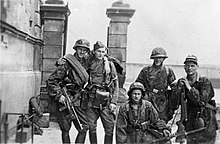 |
This is a list of notable individuals who were involved in the Warsaw Uprising, a Polish insurgence during the Second World War that begun on August 1, 1944.
| Warsaw Uprising |
|---|
 |
This is a list of notable individuals who were involved in the Warsaw Uprising, a Polish insurgence during the Second World War that begun on August 1, 1944.

Generał Tadeusz Komorowski, better known by the name Bór-Komorowski was a Polish military leader. He was appointed commander in chief a day before the capitulation of the Warsaw Uprising and following World War II, 32nd Prime Minister of Poland, 3rd Polish government-in-exile in London.

The Warsaw Uprising was a major World War II operation, in the summer of 1944, by the Polish underground resistance, led by the Polish resistance Home Army, to liberate Warsaw from German occupation. The uprising was timed to coincide with the retreat of the German forces from Poland ahead of the Soviet advance. While approaching the eastern suburbs of the city, the Red Army temporarily halted combat operations, enabling the Germans to regroup and defeat the Polish resistance and to destroy the city in retaliation. The Uprising was fought for 63 days with little outside support. It was the single largest military effort taken by any European resistance movement during World War II.
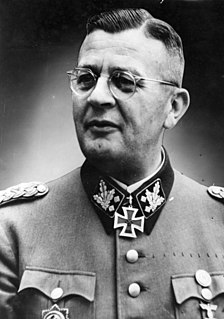
Erich Julius Eberhard von dem Bach-Zelewski was a high-ranking SS commander of Nazi Germany. During World War II, he was in charge of the Nazi security warfare against those designated by the regime as ideological enemies and any other persons deemed to present danger to the Nazi rule or Wehrmacht's rear security in the occupied territories of Eastern Europe. It mostly involved atrocities against the civilian population. In 1944 he led the brutal suppression of the Warsaw Uprising. At the end of 1941 the forces under von dem Bach numbered 14,953 Germans, mostly officers and unteroffiziere, and 238,105 local "volunteers"
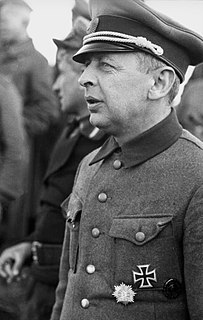
Bronislav Vladislavovich Stroganof Kaminski was a Russian anti-communist collaborationist and the commander of the Kaminski Brigade, an anti-partisan and rear-security formation made up of people from the so-called Lokot Autonomy territory in the Nazi Germany occupied areas of Russia, which was later incorporated into the Waffen-SS as the SS Sturmbrigade RONA ]. Older publications mistakenly give his first name as Mieczyslaw. Under Kaminski's command, the unit committed numerous war crimes and atrocities in the German-occupied Soviet Union and Poland.

The Warsaw Uprising began with simultaneous coordinated attacks at 17:00 hours on August 1, 1944 (W-hour). The uprising was intended to last a few days until Soviet forces arrived; however, this never happened, and the Polish forces had to fight almost without any outside assistance. Initially the battle raged throughout most of Warsaw, but after a short time it became confined to districts in the West of the town. The key factor in the battle was the massive imbalance of weapons between the two sides. The German side was extremely well equipped whilst the Polish side had, initially, barely enough ammunition for a few days. The policy of one bullet, one German allowed the Polish fighters to sustain the uprising for many weeks at the cost of their own lives. Some areas fought for a full 63 days before an agreed capitulation took place. The losses on the Polish side amounted to 18,000 soldiers killed, 25,000 wounded and over 250,000 civilians killed; those on the German side amounted to over 17,000 soldiers killed and 9,000 wounded.
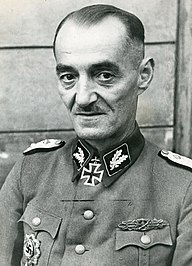
Oskar Paul Dirlewanger was a German military officer (SS-Oberführer) and war criminal who served as the founder and commander of the Nazi SS penal unit "Dirlewanger" during World War II. Serving in Poland and in Belarus, his name is closely linked to some of the most notorious crimes of the war. He also fought in World War I, the post-World War I conflicts, and the Spanish Civil War. He reportedly died after World War II while in Allied custody. According to Timothy Snyder, "in all the theaters of the Second World War, few could compete in cruelty with Dirlewanger".

Heinz Reinefarth was a German SS commander during World War II and government official in West Germany after the war. During the Warsaw Uprising of August 1944 his troops committed numerous atrocities. After the war Reinefarth became the mayor of the town of Westerland, on the isle of Sylt, and member of the Schleswig-Holstein Landtag. Polish demands for extradition were never accepted, nor was Reinefarth ever convicted of any war crime.
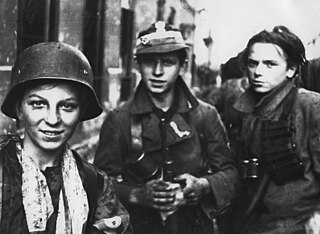
"Gray Ranks" was a codename for the underground paramilitary Polish Scouting Association during World War II.
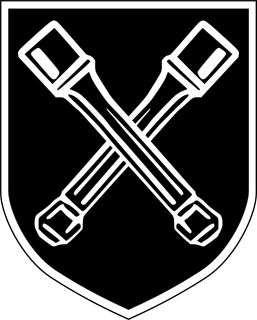
The Dirlewanger Brigade, also known as the SS-Sturmbrigade Dirlewanger (1944), or the 36th Waffen Grenadier Division of the SS, or Black Hunters, was a unit of the Waffen-SS during World War II. The unit, named after its commander Oskar Dirlewanger, consisted of convicted criminals who were not expected by Nazi Germany to survive their service with the unit. Originally formed in 1940 and first deployed for counter-insurgency duties against the Polish resistance movement, the brigade saw service in anti-partisan actions in German-occupied Eastern Europe.

Battalion Zośka was a Scouting battalion of the Polish resistance movement organisation - Home Army during World War II. It mainly consisted of members of the Szare Szeregi paramilitary Boy Scouts. It was formed in late August 1943. A part of the Radosław Group, the battalion played a major role in the Warsaw Uprising of 1944.
Azerbaijani SS volunteer formations were recruited from prisoners of war, mainly from the Soviet Union and the countries annexed by it after 1939. Nazi Germany organised them to fight against the Soviet Union.

The Wola massacre was the systematic killing of between 40,000 and 50,000 Poles in the Wola neighbourhood of the Polish capital city, Warsaw, by the German Wehrmacht and fellow Axis collaborators in the Azerbaijani Legion, as well as the mostly-Russian RONA forces, which took place from 5 to 12 August 1944. The massacre was ordered by Adolf Hitler, who directed to kill "anything that moves" to stop the Warsaw Uprising soon after it began.

Jan Mazurkiewicz, pseudonym: "Zagłoba", "Socha", "Sęp", "Radosław" was a Polish military leader and politician, colonel of Home Army and brigadier general of the Polish People's Army. Founder of the Secret Military Organization, commander of Kedyw and the Radosław Group during Warsaw Uprising. After the war, he was a political prisoner of the Stalinist period. From 1964 he was vice-president of Society of Fighters for Freedom and Democracy.
The Sub-district I of Ochota – one of territorial organisational units of the Warsaw District, which operated during the German occupation of Poland 1939–1945. It comprised the area of the Ochota district of the city of Warsaw.
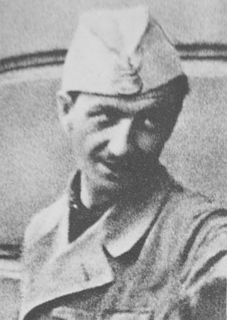
Stanisław Jankowski was an SOE agent and Polish resistance fighter during World War II, and an architect thereafter, who played a prominent role in the post-war reconstruction of Warsaw.

Radosław Group was the codename of a group of Kedyw, a Polish World War II Armia Krajowa organization, units during World War II created shortly before the outbreak of the Warsaw Uprising.

The Chrobry II Battalion was a unit, formally subordinate to the Polish Home Army (AK), which took part in the Warsaw Uprising. It was named after the Polish king Bolesław I Chrobry.
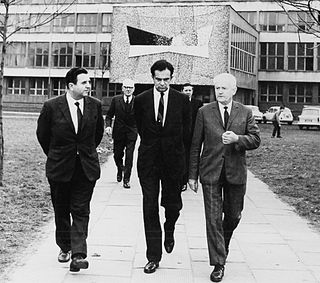
Jan Józef Więckowski nom de guerre Drogosław was a Sub-Scout Master in the Polish Scouting Movement, a 2nd Lieutenant of the Home Army and a Captain of the Polish Armed Forces, Polish resistance member during the Warsaw Uprising, both Chief and Chief of Security for the Second Company Rudy of Battalion Zośka, and a 1951 graduate of international economics from Stetson University.
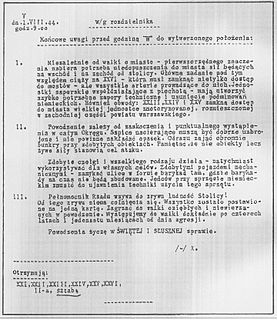
'W' Hour was the codename for the date and time that began Operation Tempest in German-occupied Warsaw, and hence the Warsaw Uprising. The exact time was 5:00 PM, 1 August 1944.